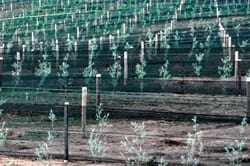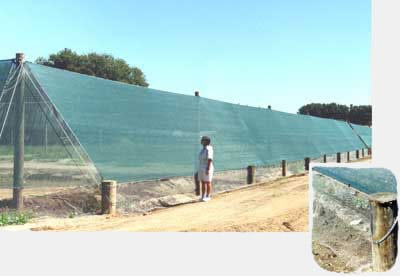Canopies for Growth Optimization
Temperature can be increased or decreased using canopies directly.
Shade canopies decrease the temperature for shade levels above about 50%. Below that, and for white fabrics, the combined effect of the reflected light and the decreased air movement, the temperatures will increase.
Coloured canopies – especially red – have additional effects leading to earlier crops in some cases.
A specialised fabric system called “winterising” designed to increase winter temperatures in nursery shade houses is discussed on the shade canopies page.
Canopies and windbreaks will also improve the effectiveness of other “added-heat” temperature control systems such as smudge pots for frost protection.
Windbreaks or Wind Fences for Growth Optimization
Wind fences have a direct affect on crop, soil and air temperature, evapotranspiration, and crop yield as per the graph below.
Greenhouse improvements
Windbrealk and canopy technology can also be used in conjunction with greenhouses.
- Hail protection:
A canopy can save a lot of broken glass! - Reduce windspeeds to cut heat loss and increase venting efficiency.
Talk to your greenhouse heating supplier about the change in fuel consumption depending on windspeed. - Reduce windspeeds to improve durability in storms.
Windbreaks are durable and economical as they let some wind through. This dramatically reduces the load compared to greenhouses that by definition are close to airtight. A windbreak to keep the worst of the storm away, and a greenhouse to keep your plants warm are a very efficient pairing.






